Strategic Analysis and Recommendations for PCS Inc. Case Study
VerifiedAdded on 2020/04/07
|22
|4995
|141
Case Study
AI Summary
This case study analyzes Physician Care Services Inc. (PCS), a profit-oriented healthcare provider offering non-emergency walk-in services. It examines the company's market position, including environmental and SWOT analyses, and identifies key stakeholder problems and concerns. The study explores challenges such as rising competition, economic downturn, and the absence of physical therapy services, along with internal issues like the major shareholder's control and lack of strategic planning. It presents alternative solutions and recommends strategies to address these problems, including expanding service offerings and developing a comprehensive strategic plan for the future. The study emphasizes the need for PCS to adapt to market changes, address stakeholder concerns, and enhance its competitive advantage. The case study also touches on the organizational structure, operational issues, and potential for future growth, concluding with a call to action for implementing the recommendations and monitoring the implementation plan.
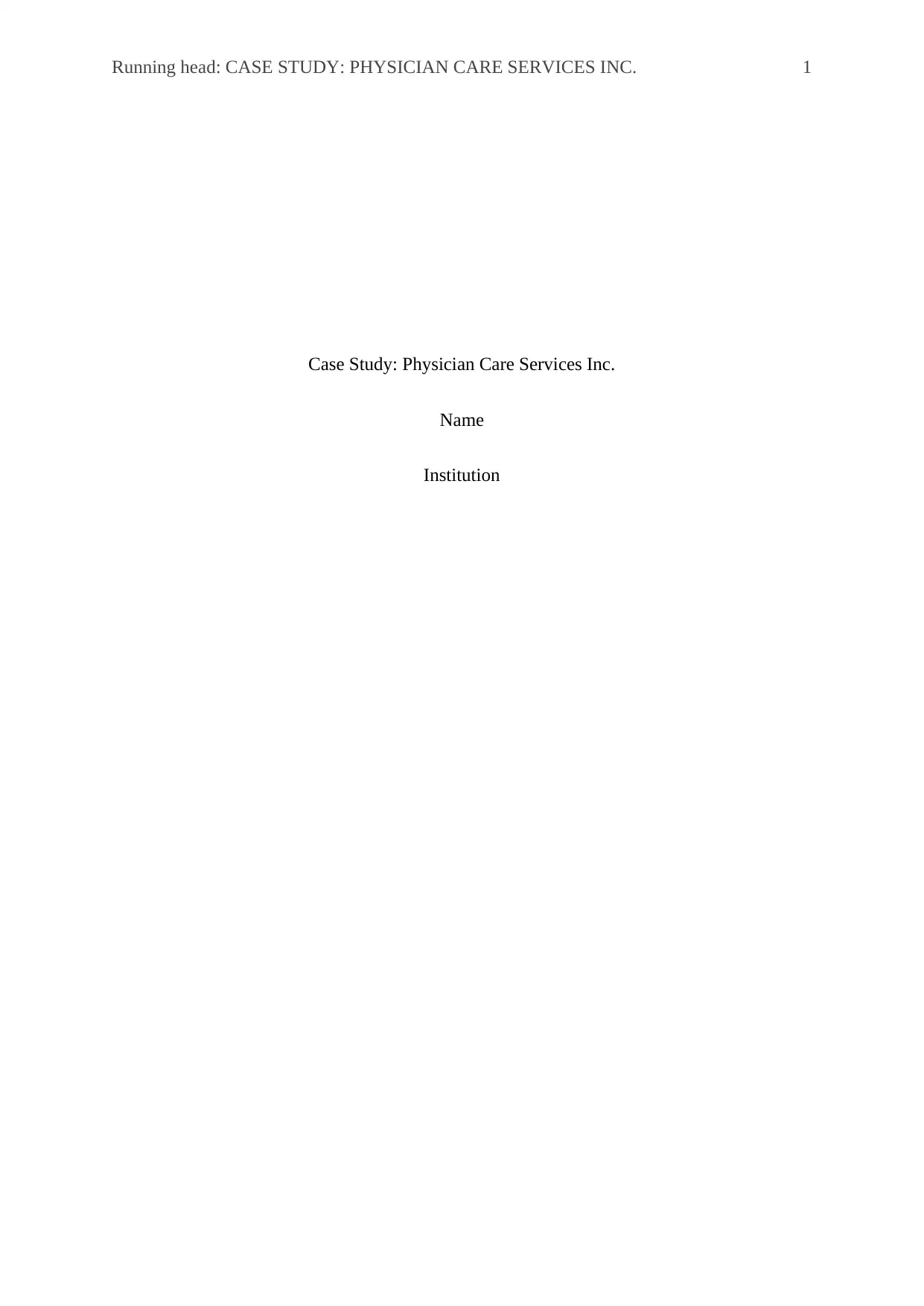
Running head: CASE STUDY: PHYSICIAN CARE SERVICES INC. 1
Case Study: Physician Care Services Inc.
Name
Institution
Case Study: Physician Care Services Inc.
Name
Institution
Paraphrase This Document
Need a fresh take? Get an instant paraphrase of this document with our AI Paraphraser
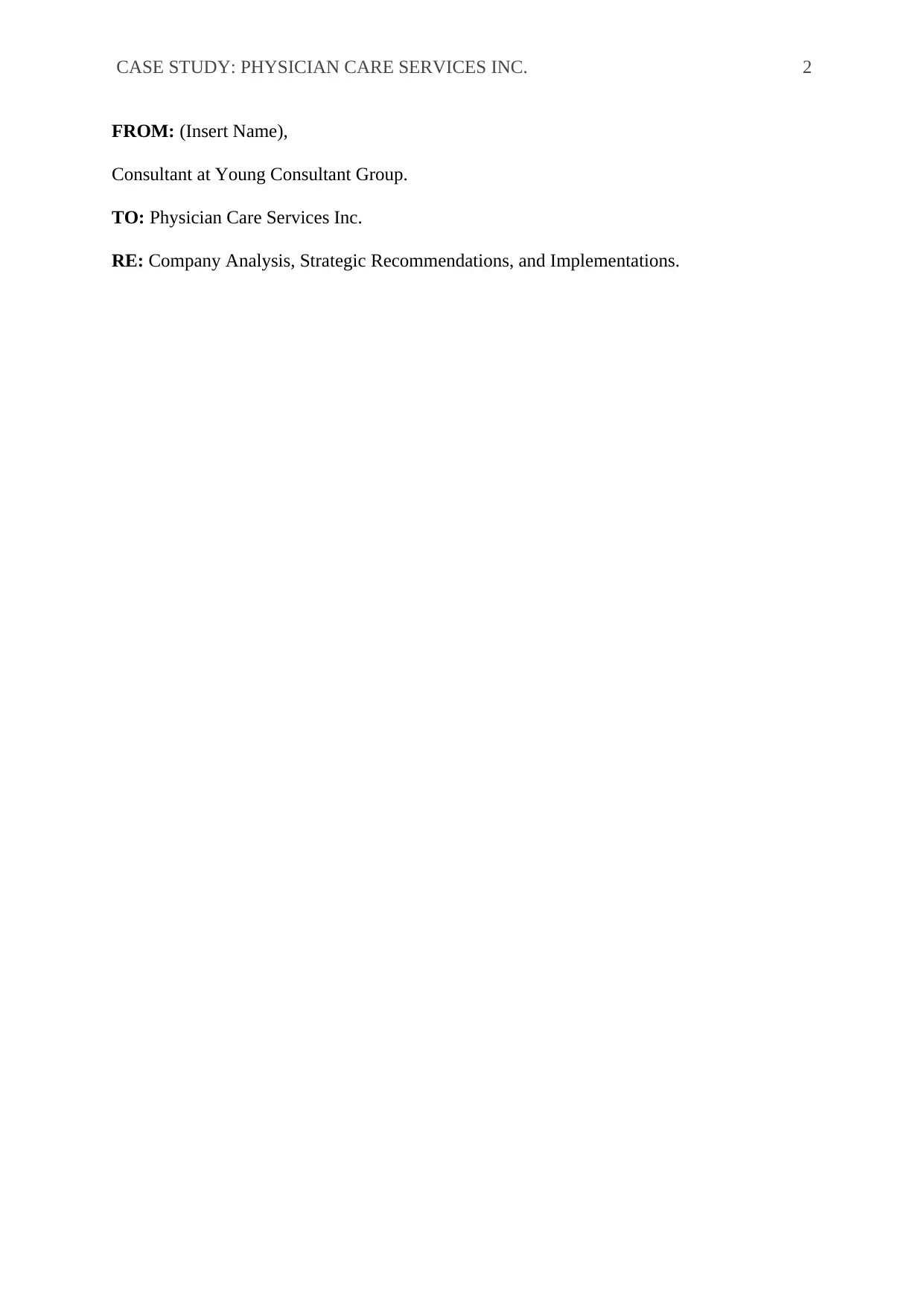
CASE STUDY: PHYSICIAN CARE SERVICES INC. 2
FROM: (Insert Name),
Consultant at Young Consultant Group.
TO: Physician Care Services Inc.
RE: Company Analysis, Strategic Recommendations, and Implementations.
FROM: (Insert Name),
Consultant at Young Consultant Group.
TO: Physician Care Services Inc.
RE: Company Analysis, Strategic Recommendations, and Implementations.
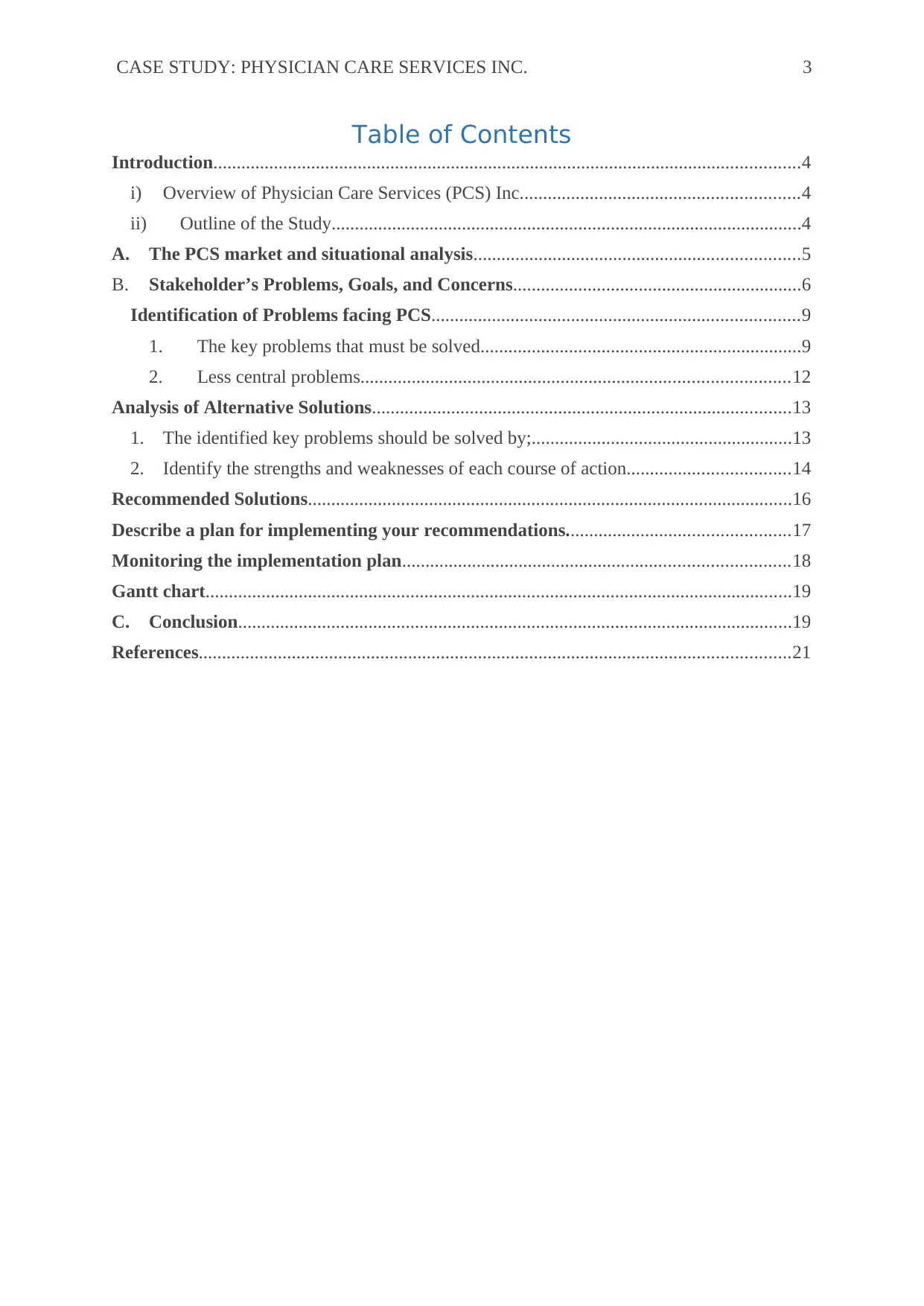
CASE STUDY: PHYSICIAN CARE SERVICES INC. 3
Table of Contents
Introduction..............................................................................................................................4
i) Overview of Physician Care Services (PCS) Inc............................................................4
ii) Outline of the Study.....................................................................................................4
A. The PCS market and situational analysis......................................................................5
B. Stakeholder’s Problems, Goals, and Concerns..............................................................6
Identification of Problems facing PCS...............................................................................9
1. The key problems that must be solved.....................................................................9
2. Less central problems............................................................................................12
Analysis of Alternative Solutions..........................................................................................13
1. The identified key problems should be solved by;........................................................13
2. Identify the strengths and weaknesses of each course of action...................................14
Recommended Solutions........................................................................................................16
Describe a plan for implementing your recommendations................................................17
Monitoring the implementation plan...................................................................................18
Gantt chart..............................................................................................................................19
C. Conclusion.......................................................................................................................19
References...............................................................................................................................21
Table of Contents
Introduction..............................................................................................................................4
i) Overview of Physician Care Services (PCS) Inc............................................................4
ii) Outline of the Study.....................................................................................................4
A. The PCS market and situational analysis......................................................................5
B. Stakeholder’s Problems, Goals, and Concerns..............................................................6
Identification of Problems facing PCS...............................................................................9
1. The key problems that must be solved.....................................................................9
2. Less central problems............................................................................................12
Analysis of Alternative Solutions..........................................................................................13
1. The identified key problems should be solved by;........................................................13
2. Identify the strengths and weaknesses of each course of action...................................14
Recommended Solutions........................................................................................................16
Describe a plan for implementing your recommendations................................................17
Monitoring the implementation plan...................................................................................18
Gantt chart..............................................................................................................................19
C. Conclusion.......................................................................................................................19
References...............................................................................................................................21
⊘ This is a preview!⊘
Do you want full access?
Subscribe today to unlock all pages.

Trusted by 1+ million students worldwide
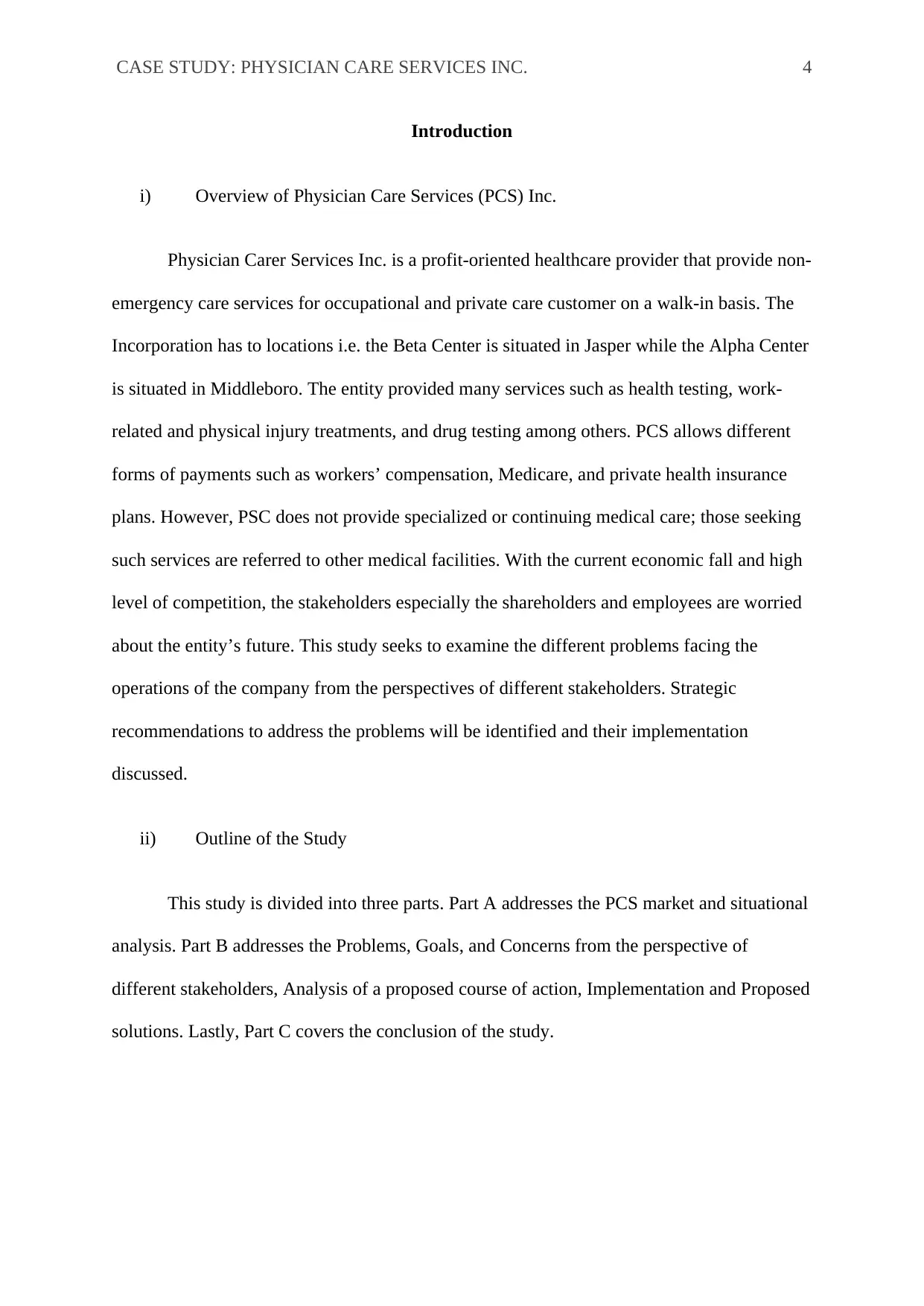
CASE STUDY: PHYSICIAN CARE SERVICES INC. 4
Introduction
i) Overview of Physician Care Services (PCS) Inc.
Physician Carer Services Inc. is a profit-oriented healthcare provider that provide non-
emergency care services for occupational and private care customer on a walk-in basis. The
Incorporation has to locations i.e. the Beta Center is situated in Jasper while the Alpha Center
is situated in Middleboro. The entity provided many services such as health testing, work-
related and physical injury treatments, and drug testing among others. PCS allows different
forms of payments such as workers’ compensation, Medicare, and private health insurance
plans. However, PSC does not provide specialized or continuing medical care; those seeking
such services are referred to other medical facilities. With the current economic fall and high
level of competition, the stakeholders especially the shareholders and employees are worried
about the entity’s future. This study seeks to examine the different problems facing the
operations of the company from the perspectives of different stakeholders. Strategic
recommendations to address the problems will be identified and their implementation
discussed.
ii) Outline of the Study
This study is divided into three parts. Part A addresses the PCS market and situational
analysis. Part B addresses the Problems, Goals, and Concerns from the perspective of
different stakeholders, Analysis of a proposed course of action, Implementation and Proposed
solutions. Lastly, Part C covers the conclusion of the study.
Introduction
i) Overview of Physician Care Services (PCS) Inc.
Physician Carer Services Inc. is a profit-oriented healthcare provider that provide non-
emergency care services for occupational and private care customer on a walk-in basis. The
Incorporation has to locations i.e. the Beta Center is situated in Jasper while the Alpha Center
is situated in Middleboro. The entity provided many services such as health testing, work-
related and physical injury treatments, and drug testing among others. PCS allows different
forms of payments such as workers’ compensation, Medicare, and private health insurance
plans. However, PSC does not provide specialized or continuing medical care; those seeking
such services are referred to other medical facilities. With the current economic fall and high
level of competition, the stakeholders especially the shareholders and employees are worried
about the entity’s future. This study seeks to examine the different problems facing the
operations of the company from the perspectives of different stakeholders. Strategic
recommendations to address the problems will be identified and their implementation
discussed.
ii) Outline of the Study
This study is divided into three parts. Part A addresses the PCS market and situational
analysis. Part B addresses the Problems, Goals, and Concerns from the perspective of
different stakeholders, Analysis of a proposed course of action, Implementation and Proposed
solutions. Lastly, Part C covers the conclusion of the study.
Paraphrase This Document
Need a fresh take? Get an instant paraphrase of this document with our AI Paraphraser
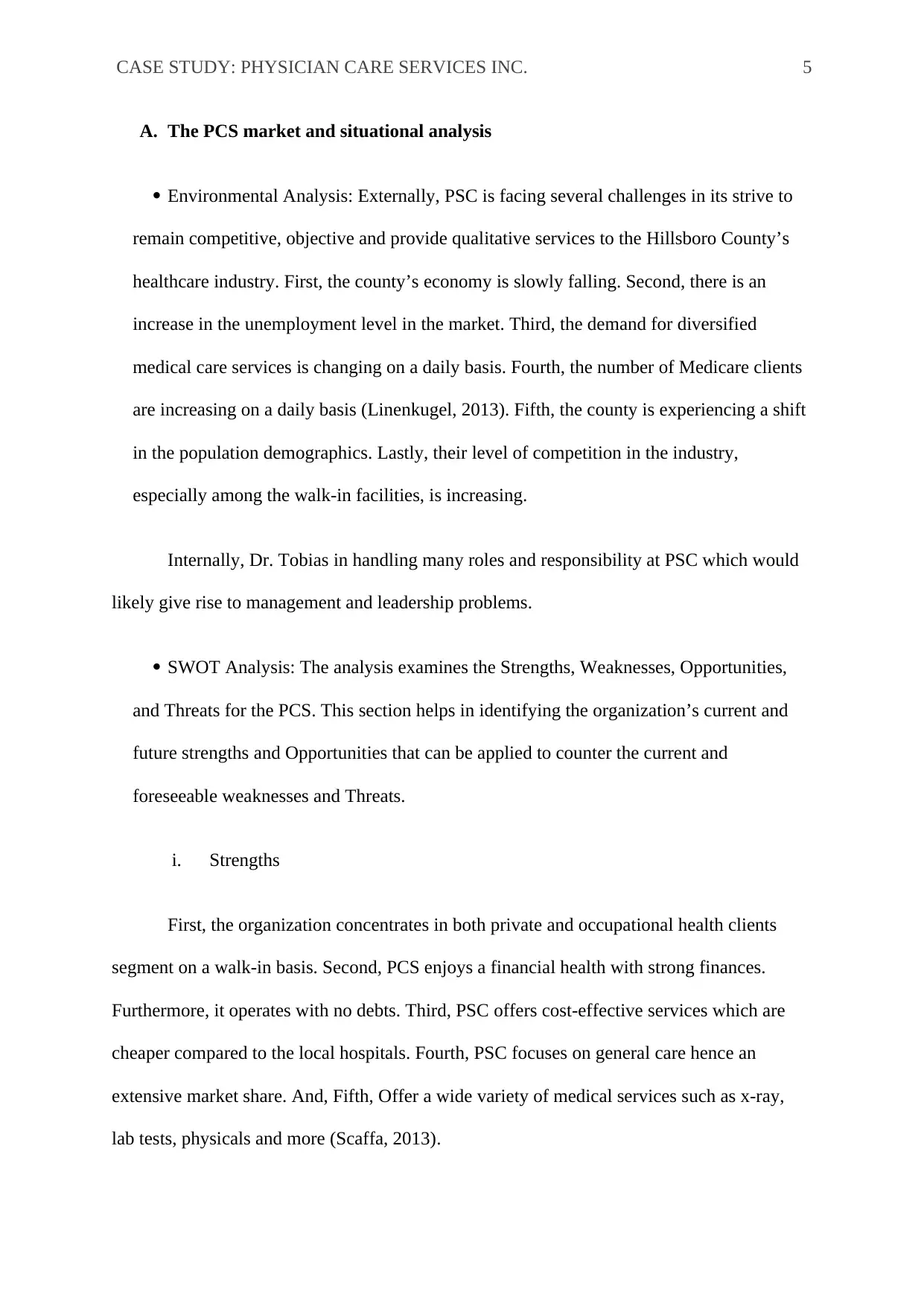
CASE STUDY: PHYSICIAN CARE SERVICES INC. 5
A. The PCS market and situational analysis
Environmental Analysis: Externally, PSC is facing several challenges in its strive to
remain competitive, objective and provide qualitative services to the Hillsboro County’s
healthcare industry. First, the county’s economy is slowly falling. Second, there is an
increase in the unemployment level in the market. Third, the demand for diversified
medical care services is changing on a daily basis. Fourth, the number of Medicare clients
are increasing on a daily basis (Linenkugel, 2013). Fifth, the county is experiencing a shift
in the population demographics. Lastly, their level of competition in the industry,
especially among the walk-in facilities, is increasing.
Internally, Dr. Tobias in handling many roles and responsibility at PSC which would
likely give rise to management and leadership problems.
SWOT Analysis: The analysis examines the Strengths, Weaknesses, Opportunities,
and Threats for the PCS. This section helps in identifying the organization’s current and
future strengths and Opportunities that can be applied to counter the current and
foreseeable weaknesses and Threats.
i. Strengths
First, the organization concentrates in both private and occupational health clients
segment on a walk-in basis. Second, PCS enjoys a financial health with strong finances.
Furthermore, it operates with no debts. Third, PSC offers cost-effective services which are
cheaper compared to the local hospitals. Fourth, PSC focuses on general care hence an
extensive market share. And, Fifth, Offer a wide variety of medical services such as x-ray,
lab tests, physicals and more (Scaffa, 2013).
A. The PCS market and situational analysis
Environmental Analysis: Externally, PSC is facing several challenges in its strive to
remain competitive, objective and provide qualitative services to the Hillsboro County’s
healthcare industry. First, the county’s economy is slowly falling. Second, there is an
increase in the unemployment level in the market. Third, the demand for diversified
medical care services is changing on a daily basis. Fourth, the number of Medicare clients
are increasing on a daily basis (Linenkugel, 2013). Fifth, the county is experiencing a shift
in the population demographics. Lastly, their level of competition in the industry,
especially among the walk-in facilities, is increasing.
Internally, Dr. Tobias in handling many roles and responsibility at PSC which would
likely give rise to management and leadership problems.
SWOT Analysis: The analysis examines the Strengths, Weaknesses, Opportunities,
and Threats for the PCS. This section helps in identifying the organization’s current and
future strengths and Opportunities that can be applied to counter the current and
foreseeable weaknesses and Threats.
i. Strengths
First, the organization concentrates in both private and occupational health clients
segment on a walk-in basis. Second, PCS enjoys a financial health with strong finances.
Furthermore, it operates with no debts. Third, PSC offers cost-effective services which are
cheaper compared to the local hospitals. Fourth, PSC focuses on general care hence an
extensive market share. And, Fifth, Offer a wide variety of medical services such as x-ray,
lab tests, physicals and more (Scaffa, 2013).
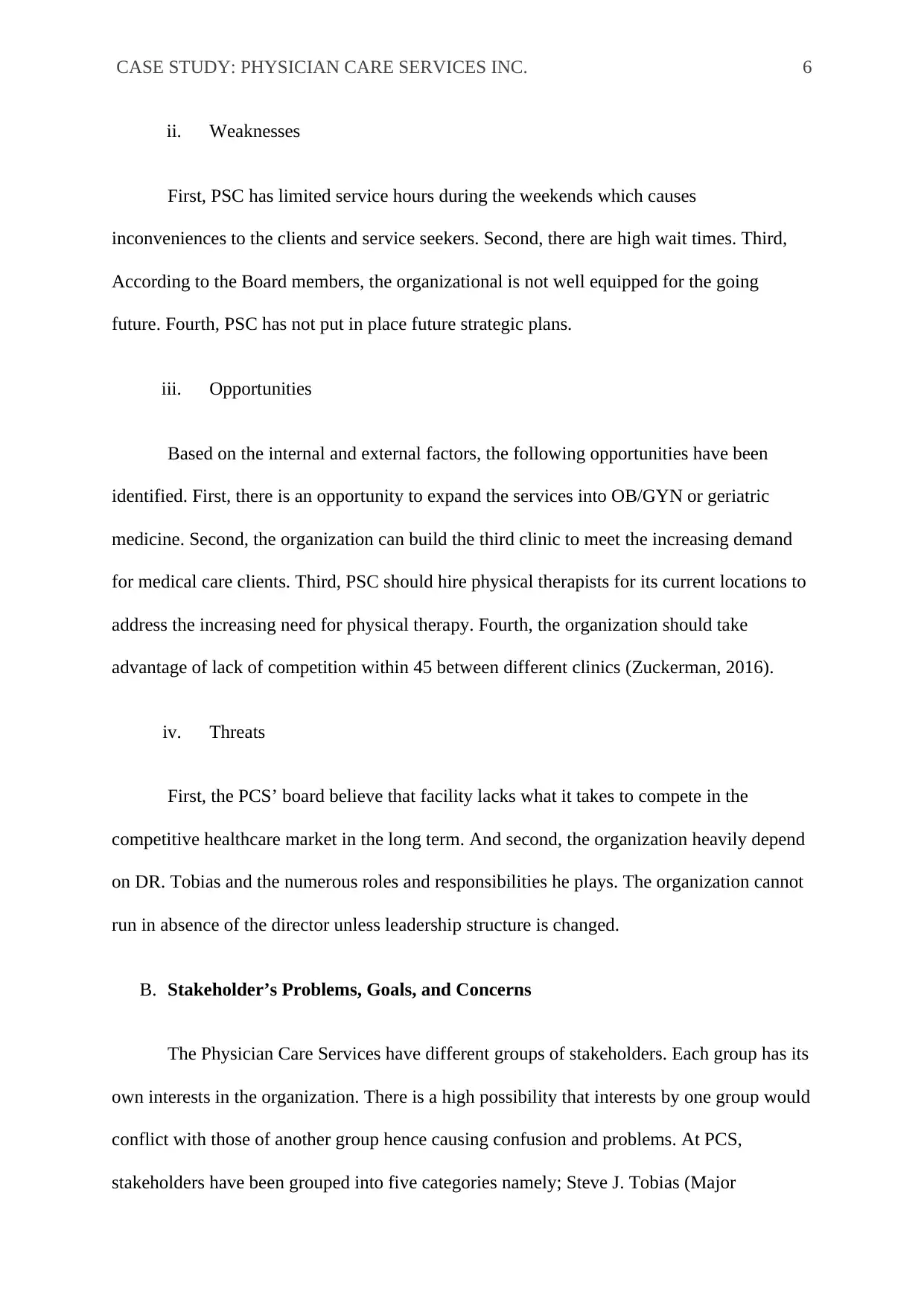
CASE STUDY: PHYSICIAN CARE SERVICES INC. 6
ii. Weaknesses
First, PSC has limited service hours during the weekends which causes
inconveniences to the clients and service seekers. Second, there are high wait times. Third,
According to the Board members, the organizational is not well equipped for the going
future. Fourth, PSC has not put in place future strategic plans.
iii. Opportunities
Based on the internal and external factors, the following opportunities have been
identified. First, there is an opportunity to expand the services into OB/GYN or geriatric
medicine. Second, the organization can build the third clinic to meet the increasing demand
for medical care clients. Third, PSC should hire physical therapists for its current locations to
address the increasing need for physical therapy. Fourth, the organization should take
advantage of lack of competition within 45 between different clinics (Zuckerman, 2016).
iv. Threats
First, the PCS’ board believe that facility lacks what it takes to compete in the
competitive healthcare market in the long term. And second, the organization heavily depend
on DR. Tobias and the numerous roles and responsibilities he plays. The organization cannot
run in absence of the director unless leadership structure is changed.
B. Stakeholder’s Problems, Goals, and Concerns
The Physician Care Services have different groups of stakeholders. Each group has its
own interests in the organization. There is a high possibility that interests by one group would
conflict with those of another group hence causing confusion and problems. At PCS,
stakeholders have been grouped into five categories namely; Steve J. Tobias (Major
ii. Weaknesses
First, PSC has limited service hours during the weekends which causes
inconveniences to the clients and service seekers. Second, there are high wait times. Third,
According to the Board members, the organizational is not well equipped for the going
future. Fourth, PSC has not put in place future strategic plans.
iii. Opportunities
Based on the internal and external factors, the following opportunities have been
identified. First, there is an opportunity to expand the services into OB/GYN or geriatric
medicine. Second, the organization can build the third clinic to meet the increasing demand
for medical care clients. Third, PSC should hire physical therapists for its current locations to
address the increasing need for physical therapy. Fourth, the organization should take
advantage of lack of competition within 45 between different clinics (Zuckerman, 2016).
iv. Threats
First, the PCS’ board believe that facility lacks what it takes to compete in the
competitive healthcare market in the long term. And second, the organization heavily depend
on DR. Tobias and the numerous roles and responsibilities he plays. The organization cannot
run in absence of the director unless leadership structure is changed.
B. Stakeholder’s Problems, Goals, and Concerns
The Physician Care Services have different groups of stakeholders. Each group has its
own interests in the organization. There is a high possibility that interests by one group would
conflict with those of another group hence causing confusion and problems. At PCS,
stakeholders have been grouped into five categories namely; Steve J. Tobias (Major
⊘ This is a preview!⊘
Do you want full access?
Subscribe today to unlock all pages.

Trusted by 1+ million students worldwide
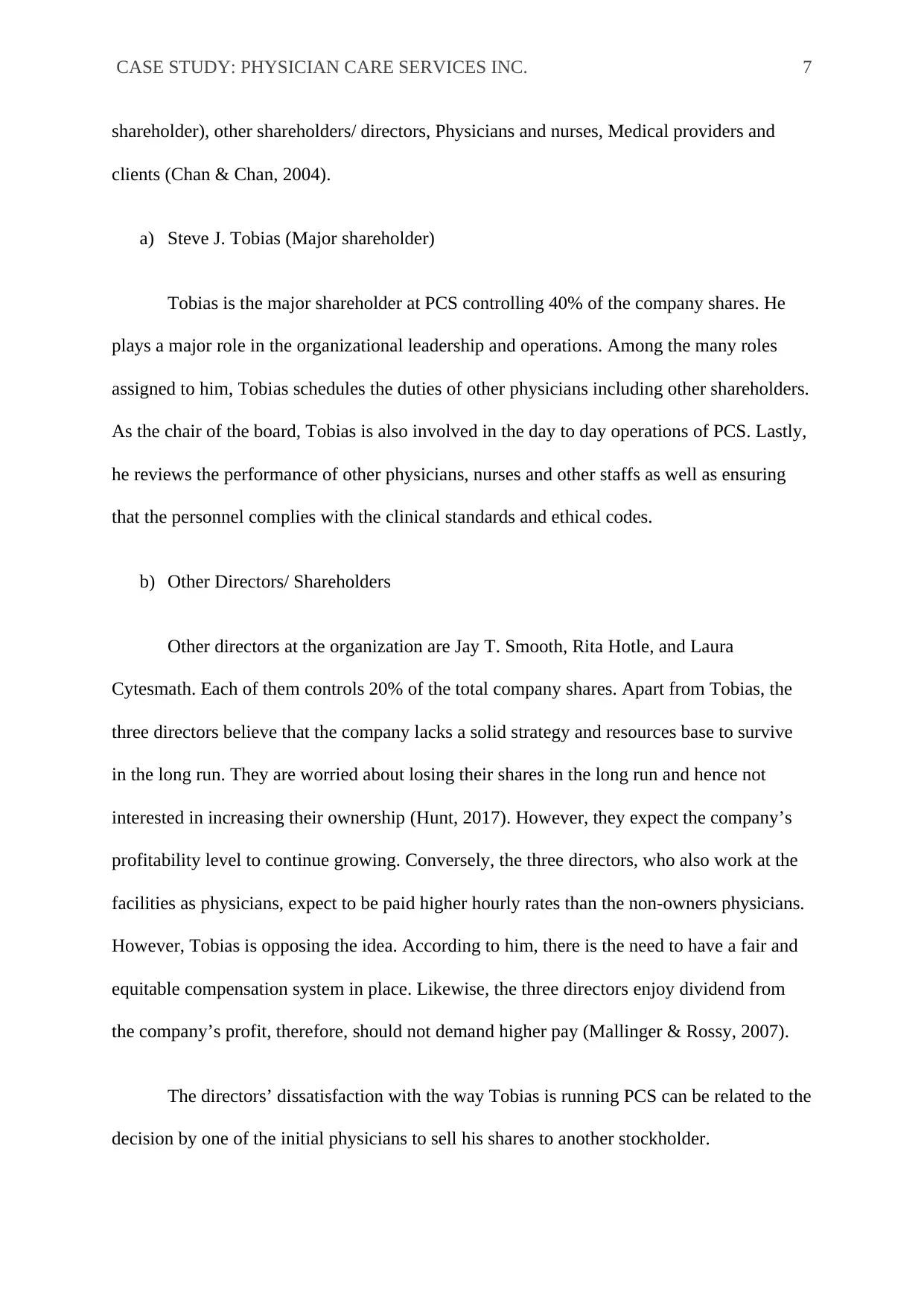
CASE STUDY: PHYSICIAN CARE SERVICES INC. 7
shareholder), other shareholders/ directors, Physicians and nurses, Medical providers and
clients (Chan & Chan, 2004).
a) Steve J. Tobias (Major shareholder)
Tobias is the major shareholder at PCS controlling 40% of the company shares. He
plays a major role in the organizational leadership and operations. Among the many roles
assigned to him, Tobias schedules the duties of other physicians including other shareholders.
As the chair of the board, Tobias is also involved in the day to day operations of PCS. Lastly,
he reviews the performance of other physicians, nurses and other staffs as well as ensuring
that the personnel complies with the clinical standards and ethical codes.
b) Other Directors/ Shareholders
Other directors at the organization are Jay T. Smooth, Rita Hotle, and Laura
Cytesmath. Each of them controls 20% of the total company shares. Apart from Tobias, the
three directors believe that the company lacks a solid strategy and resources base to survive
in the long run. They are worried about losing their shares in the long run and hence not
interested in increasing their ownership (Hunt, 2017). However, they expect the company’s
profitability level to continue growing. Conversely, the three directors, who also work at the
facilities as physicians, expect to be paid higher hourly rates than the non-owners physicians.
However, Tobias is opposing the idea. According to him, there is the need to have a fair and
equitable compensation system in place. Likewise, the three directors enjoy dividend from
the company’s profit, therefore, should not demand higher pay (Mallinger & Rossy, 2007).
The directors’ dissatisfaction with the way Tobias is running PCS can be related to the
decision by one of the initial physicians to sell his shares to another stockholder.
shareholder), other shareholders/ directors, Physicians and nurses, Medical providers and
clients (Chan & Chan, 2004).
a) Steve J. Tobias (Major shareholder)
Tobias is the major shareholder at PCS controlling 40% of the company shares. He
plays a major role in the organizational leadership and operations. Among the many roles
assigned to him, Tobias schedules the duties of other physicians including other shareholders.
As the chair of the board, Tobias is also involved in the day to day operations of PCS. Lastly,
he reviews the performance of other physicians, nurses and other staffs as well as ensuring
that the personnel complies with the clinical standards and ethical codes.
b) Other Directors/ Shareholders
Other directors at the organization are Jay T. Smooth, Rita Hotle, and Laura
Cytesmath. Each of them controls 20% of the total company shares. Apart from Tobias, the
three directors believe that the company lacks a solid strategy and resources base to survive
in the long run. They are worried about losing their shares in the long run and hence not
interested in increasing their ownership (Hunt, 2017). However, they expect the company’s
profitability level to continue growing. Conversely, the three directors, who also work at the
facilities as physicians, expect to be paid higher hourly rates than the non-owners physicians.
However, Tobias is opposing the idea. According to him, there is the need to have a fair and
equitable compensation system in place. Likewise, the three directors enjoy dividend from
the company’s profit, therefore, should not demand higher pay (Mallinger & Rossy, 2007).
The directors’ dissatisfaction with the way Tobias is running PCS can be related to the
decision by one of the initial physicians to sell his shares to another stockholder.
Paraphrase This Document
Need a fresh take? Get an instant paraphrase of this document with our AI Paraphraser
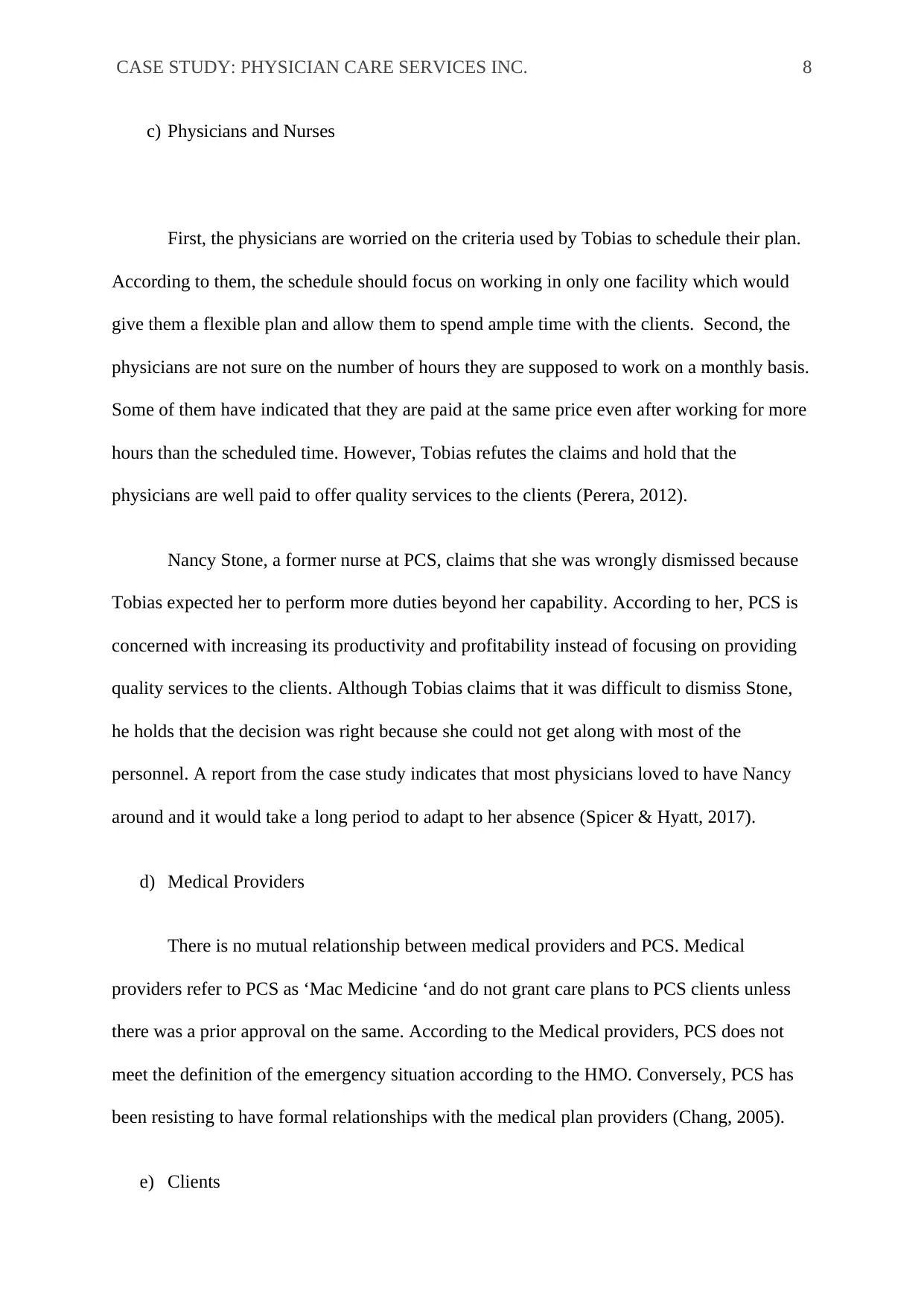
CASE STUDY: PHYSICIAN CARE SERVICES INC. 8
c) Physicians and Nurses
First, the physicians are worried on the criteria used by Tobias to schedule their plan.
According to them, the schedule should focus on working in only one facility which would
give them a flexible plan and allow them to spend ample time with the clients. Second, the
physicians are not sure on the number of hours they are supposed to work on a monthly basis.
Some of them have indicated that they are paid at the same price even after working for more
hours than the scheduled time. However, Tobias refutes the claims and hold that the
physicians are well paid to offer quality services to the clients (Perera, 2012).
Nancy Stone, a former nurse at PCS, claims that she was wrongly dismissed because
Tobias expected her to perform more duties beyond her capability. According to her, PCS is
concerned with increasing its productivity and profitability instead of focusing on providing
quality services to the clients. Although Tobias claims that it was difficult to dismiss Stone,
he holds that the decision was right because she could not get along with most of the
personnel. A report from the case study indicates that most physicians loved to have Nancy
around and it would take a long period to adapt to her absence (Spicer & Hyatt, 2017).
d) Medical Providers
There is no mutual relationship between medical providers and PCS. Medical
providers refer to PCS as ‘Mac Medicine ‘and do not grant care plans to PCS clients unless
there was a prior approval on the same. According to the Medical providers, PCS does not
meet the definition of the emergency situation according to the HMO. Conversely, PCS has
been resisting to have formal relationships with the medical plan providers (Chang, 2005).
e) Clients
c) Physicians and Nurses
First, the physicians are worried on the criteria used by Tobias to schedule their plan.
According to them, the schedule should focus on working in only one facility which would
give them a flexible plan and allow them to spend ample time with the clients. Second, the
physicians are not sure on the number of hours they are supposed to work on a monthly basis.
Some of them have indicated that they are paid at the same price even after working for more
hours than the scheduled time. However, Tobias refutes the claims and hold that the
physicians are well paid to offer quality services to the clients (Perera, 2012).
Nancy Stone, a former nurse at PCS, claims that she was wrongly dismissed because
Tobias expected her to perform more duties beyond her capability. According to her, PCS is
concerned with increasing its productivity and profitability instead of focusing on providing
quality services to the clients. Although Tobias claims that it was difficult to dismiss Stone,
he holds that the decision was right because she could not get along with most of the
personnel. A report from the case study indicates that most physicians loved to have Nancy
around and it would take a long period to adapt to her absence (Spicer & Hyatt, 2017).
d) Medical Providers
There is no mutual relationship between medical providers and PCS. Medical
providers refer to PCS as ‘Mac Medicine ‘and do not grant care plans to PCS clients unless
there was a prior approval on the same. According to the Medical providers, PCS does not
meet the definition of the emergency situation according to the HMO. Conversely, PCS has
been resisting to have formal relationships with the medical plan providers (Chang, 2005).
e) Clients
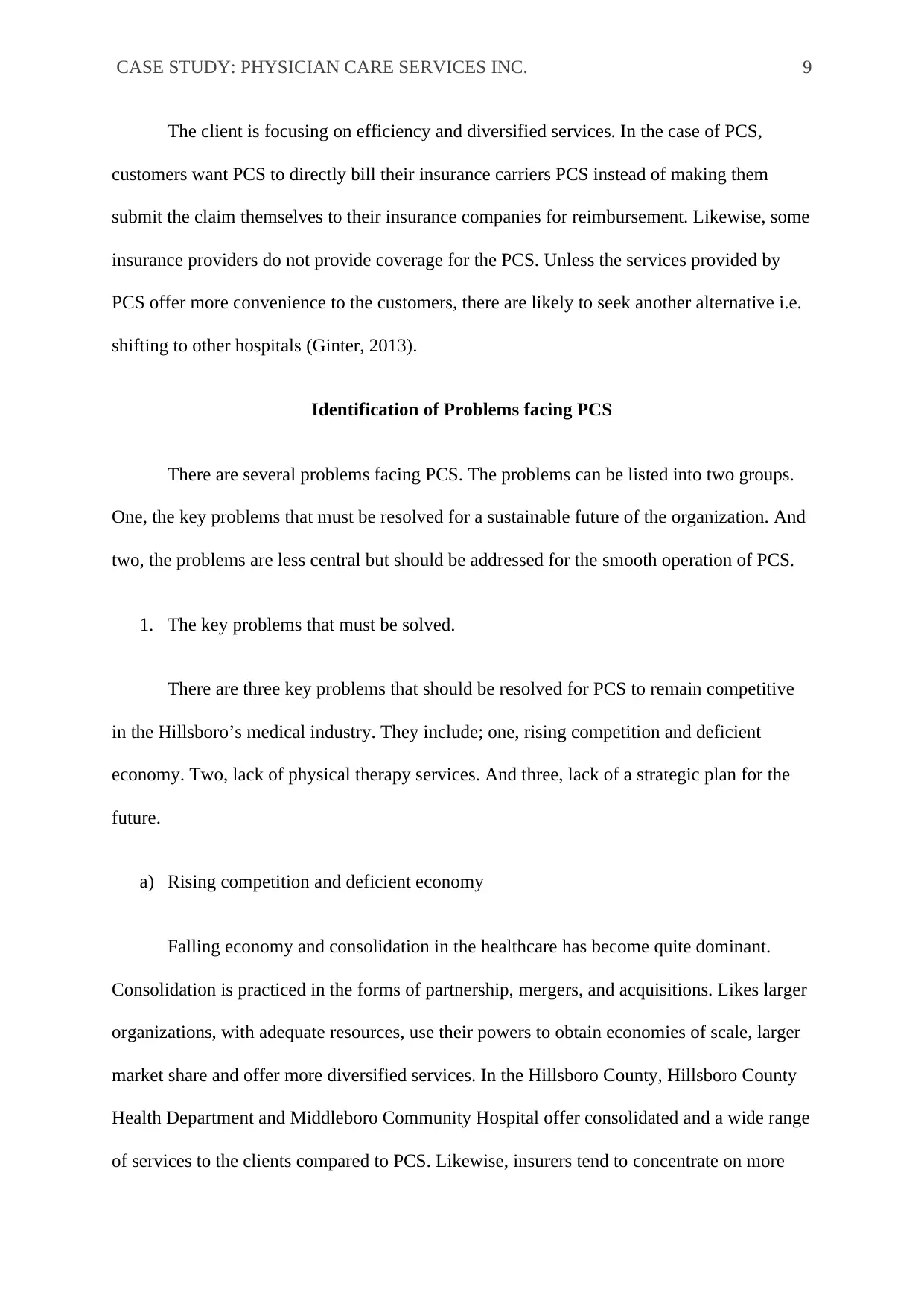
CASE STUDY: PHYSICIAN CARE SERVICES INC. 9
The client is focusing on efficiency and diversified services. In the case of PCS,
customers want PCS to directly bill their insurance carriers PCS instead of making them
submit the claim themselves to their insurance companies for reimbursement. Likewise, some
insurance providers do not provide coverage for the PCS. Unless the services provided by
PCS offer more convenience to the customers, there are likely to seek another alternative i.e.
shifting to other hospitals (Ginter, 2013).
Identification of Problems facing PCS
There are several problems facing PCS. The problems can be listed into two groups.
One, the key problems that must be resolved for a sustainable future of the organization. And
two, the problems are less central but should be addressed for the smooth operation of PCS.
1. The key problems that must be solved.
There are three key problems that should be resolved for PCS to remain competitive
in the Hillsboro’s medical industry. They include; one, rising competition and deficient
economy. Two, lack of physical therapy services. And three, lack of a strategic plan for the
future.
a) Rising competition and deficient economy
Falling economy and consolidation in the healthcare has become quite dominant.
Consolidation is practiced in the forms of partnership, mergers, and acquisitions. Likes larger
organizations, with adequate resources, use their powers to obtain economies of scale, larger
market share and offer more diversified services. In the Hillsboro County, Hillsboro County
Health Department and Middleboro Community Hospital offer consolidated and a wide range
of services to the clients compared to PCS. Likewise, insurers tend to concentrate on more
The client is focusing on efficiency and diversified services. In the case of PCS,
customers want PCS to directly bill their insurance carriers PCS instead of making them
submit the claim themselves to their insurance companies for reimbursement. Likewise, some
insurance providers do not provide coverage for the PCS. Unless the services provided by
PCS offer more convenience to the customers, there are likely to seek another alternative i.e.
shifting to other hospitals (Ginter, 2013).
Identification of Problems facing PCS
There are several problems facing PCS. The problems can be listed into two groups.
One, the key problems that must be resolved for a sustainable future of the organization. And
two, the problems are less central but should be addressed for the smooth operation of PCS.
1. The key problems that must be solved.
There are three key problems that should be resolved for PCS to remain competitive
in the Hillsboro’s medical industry. They include; one, rising competition and deficient
economy. Two, lack of physical therapy services. And three, lack of a strategic plan for the
future.
a) Rising competition and deficient economy
Falling economy and consolidation in the healthcare has become quite dominant.
Consolidation is practiced in the forms of partnership, mergers, and acquisitions. Likes larger
organizations, with adequate resources, use their powers to obtain economies of scale, larger
market share and offer more diversified services. In the Hillsboro County, Hillsboro County
Health Department and Middleboro Community Hospital offer consolidated and a wide range
of services to the clients compared to PCS. Likewise, insurers tend to concentrate on more
⊘ This is a preview!⊘
Do you want full access?
Subscribe today to unlock all pages.

Trusted by 1+ million students worldwide
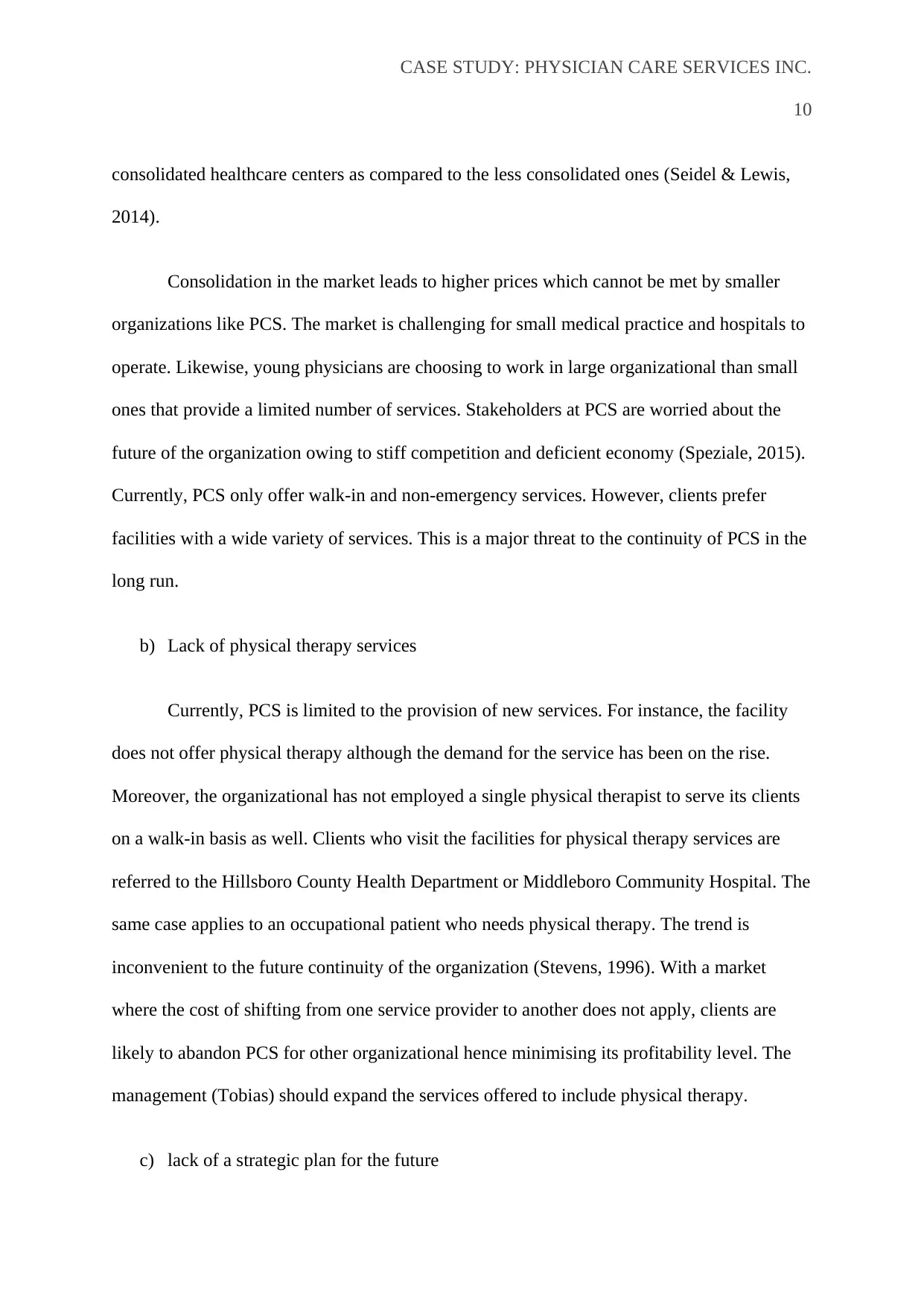
CASE STUDY: PHYSICIAN CARE SERVICES INC.
10
consolidated healthcare centers as compared to the less consolidated ones (Seidel & Lewis,
2014).
Consolidation in the market leads to higher prices which cannot be met by smaller
organizations like PCS. The market is challenging for small medical practice and hospitals to
operate. Likewise, young physicians are choosing to work in large organizational than small
ones that provide a limited number of services. Stakeholders at PCS are worried about the
future of the organization owing to stiff competition and deficient economy (Speziale, 2015).
Currently, PCS only offer walk-in and non-emergency services. However, clients prefer
facilities with a wide variety of services. This is a major threat to the continuity of PCS in the
long run.
b) Lack of physical therapy services
Currently, PCS is limited to the provision of new services. For instance, the facility
does not offer physical therapy although the demand for the service has been on the rise.
Moreover, the organizational has not employed a single physical therapist to serve its clients
on a walk-in basis as well. Clients who visit the facilities for physical therapy services are
referred to the Hillsboro County Health Department or Middleboro Community Hospital. The
same case applies to an occupational patient who needs physical therapy. The trend is
inconvenient to the future continuity of the organization (Stevens, 1996). With a market
where the cost of shifting from one service provider to another does not apply, clients are
likely to abandon PCS for other organizational hence minimising its profitability level. The
management (Tobias) should expand the services offered to include physical therapy.
c) lack of a strategic plan for the future
10
consolidated healthcare centers as compared to the less consolidated ones (Seidel & Lewis,
2014).
Consolidation in the market leads to higher prices which cannot be met by smaller
organizations like PCS. The market is challenging for small medical practice and hospitals to
operate. Likewise, young physicians are choosing to work in large organizational than small
ones that provide a limited number of services. Stakeholders at PCS are worried about the
future of the organization owing to stiff competition and deficient economy (Speziale, 2015).
Currently, PCS only offer walk-in and non-emergency services. However, clients prefer
facilities with a wide variety of services. This is a major threat to the continuity of PCS in the
long run.
b) Lack of physical therapy services
Currently, PCS is limited to the provision of new services. For instance, the facility
does not offer physical therapy although the demand for the service has been on the rise.
Moreover, the organizational has not employed a single physical therapist to serve its clients
on a walk-in basis as well. Clients who visit the facilities for physical therapy services are
referred to the Hillsboro County Health Department or Middleboro Community Hospital. The
same case applies to an occupational patient who needs physical therapy. The trend is
inconvenient to the future continuity of the organization (Stevens, 1996). With a market
where the cost of shifting from one service provider to another does not apply, clients are
likely to abandon PCS for other organizational hence minimising its profitability level. The
management (Tobias) should expand the services offered to include physical therapy.
c) lack of a strategic plan for the future
Paraphrase This Document
Need a fresh take? Get an instant paraphrase of this document with our AI Paraphraser
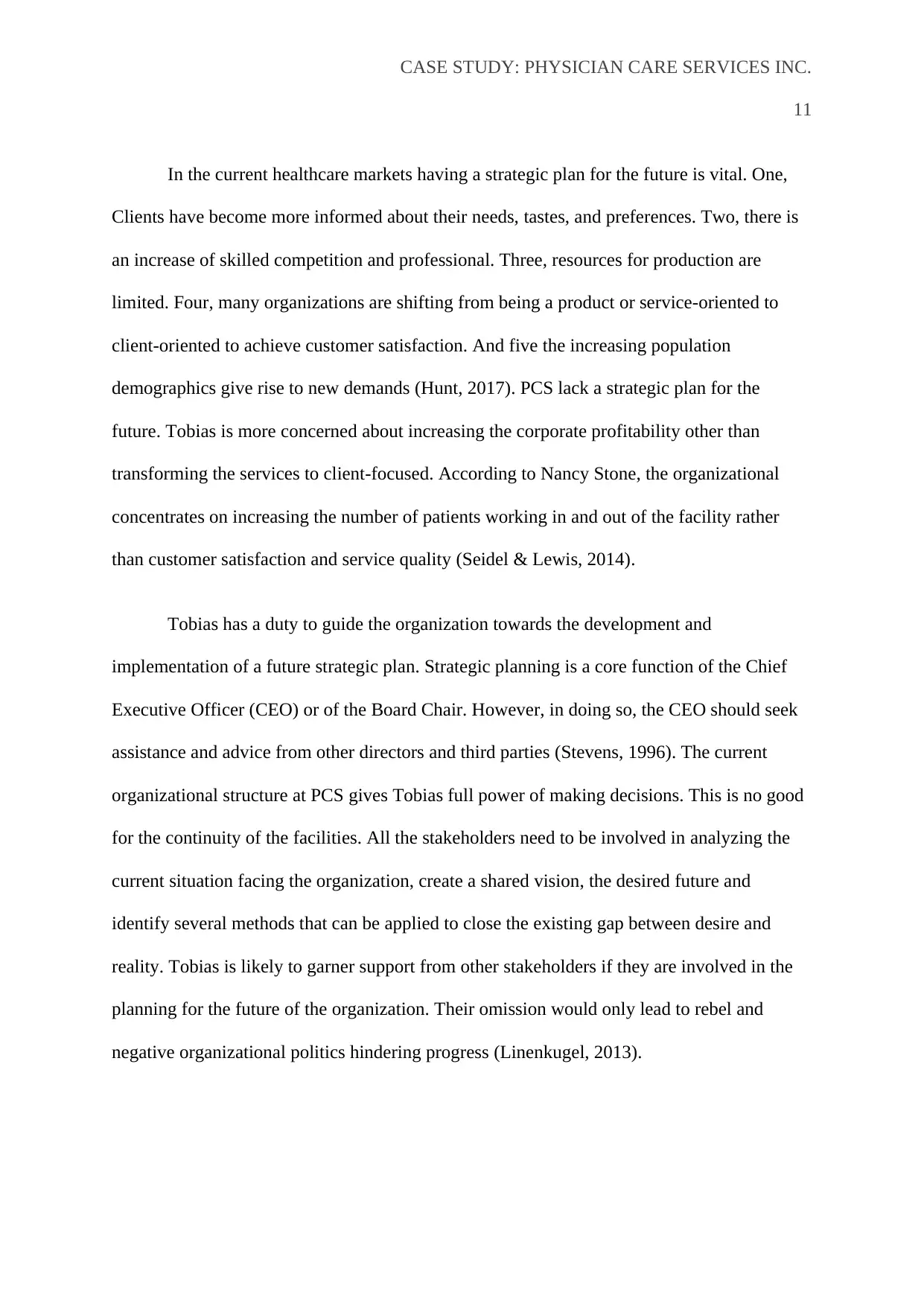
CASE STUDY: PHYSICIAN CARE SERVICES INC.
11
In the current healthcare markets having a strategic plan for the future is vital. One,
Clients have become more informed about their needs, tastes, and preferences. Two, there is
an increase of skilled competition and professional. Three, resources for production are
limited. Four, many organizations are shifting from being a product or service-oriented to
client-oriented to achieve customer satisfaction. And five the increasing population
demographics give rise to new demands (Hunt, 2017). PCS lack a strategic plan for the
future. Tobias is more concerned about increasing the corporate profitability other than
transforming the services to client-focused. According to Nancy Stone, the organizational
concentrates on increasing the number of patients working in and out of the facility rather
than customer satisfaction and service quality (Seidel & Lewis, 2014).
Tobias has a duty to guide the organization towards the development and
implementation of a future strategic plan. Strategic planning is a core function of the Chief
Executive Officer (CEO) or of the Board Chair. However, in doing so, the CEO should seek
assistance and advice from other directors and third parties (Stevens, 1996). The current
organizational structure at PCS gives Tobias full power of making decisions. This is no good
for the continuity of the facilities. All the stakeholders need to be involved in analyzing the
current situation facing the organization, create a shared vision, the desired future and
identify several methods that can be applied to close the existing gap between desire and
reality. Tobias is likely to garner support from other stakeholders if they are involved in the
planning for the future of the organization. Their omission would only lead to rebel and
negative organizational politics hindering progress (Linenkugel, 2013).
11
In the current healthcare markets having a strategic plan for the future is vital. One,
Clients have become more informed about their needs, tastes, and preferences. Two, there is
an increase of skilled competition and professional. Three, resources for production are
limited. Four, many organizations are shifting from being a product or service-oriented to
client-oriented to achieve customer satisfaction. And five the increasing population
demographics give rise to new demands (Hunt, 2017). PCS lack a strategic plan for the
future. Tobias is more concerned about increasing the corporate profitability other than
transforming the services to client-focused. According to Nancy Stone, the organizational
concentrates on increasing the number of patients working in and out of the facility rather
than customer satisfaction and service quality (Seidel & Lewis, 2014).
Tobias has a duty to guide the organization towards the development and
implementation of a future strategic plan. Strategic planning is a core function of the Chief
Executive Officer (CEO) or of the Board Chair. However, in doing so, the CEO should seek
assistance and advice from other directors and third parties (Stevens, 1996). The current
organizational structure at PCS gives Tobias full power of making decisions. This is no good
for the continuity of the facilities. All the stakeholders need to be involved in analyzing the
current situation facing the organization, create a shared vision, the desired future and
identify several methods that can be applied to close the existing gap between desire and
reality. Tobias is likely to garner support from other stakeholders if they are involved in the
planning for the future of the organization. Their omission would only lead to rebel and
negative organizational politics hindering progress (Linenkugel, 2013).
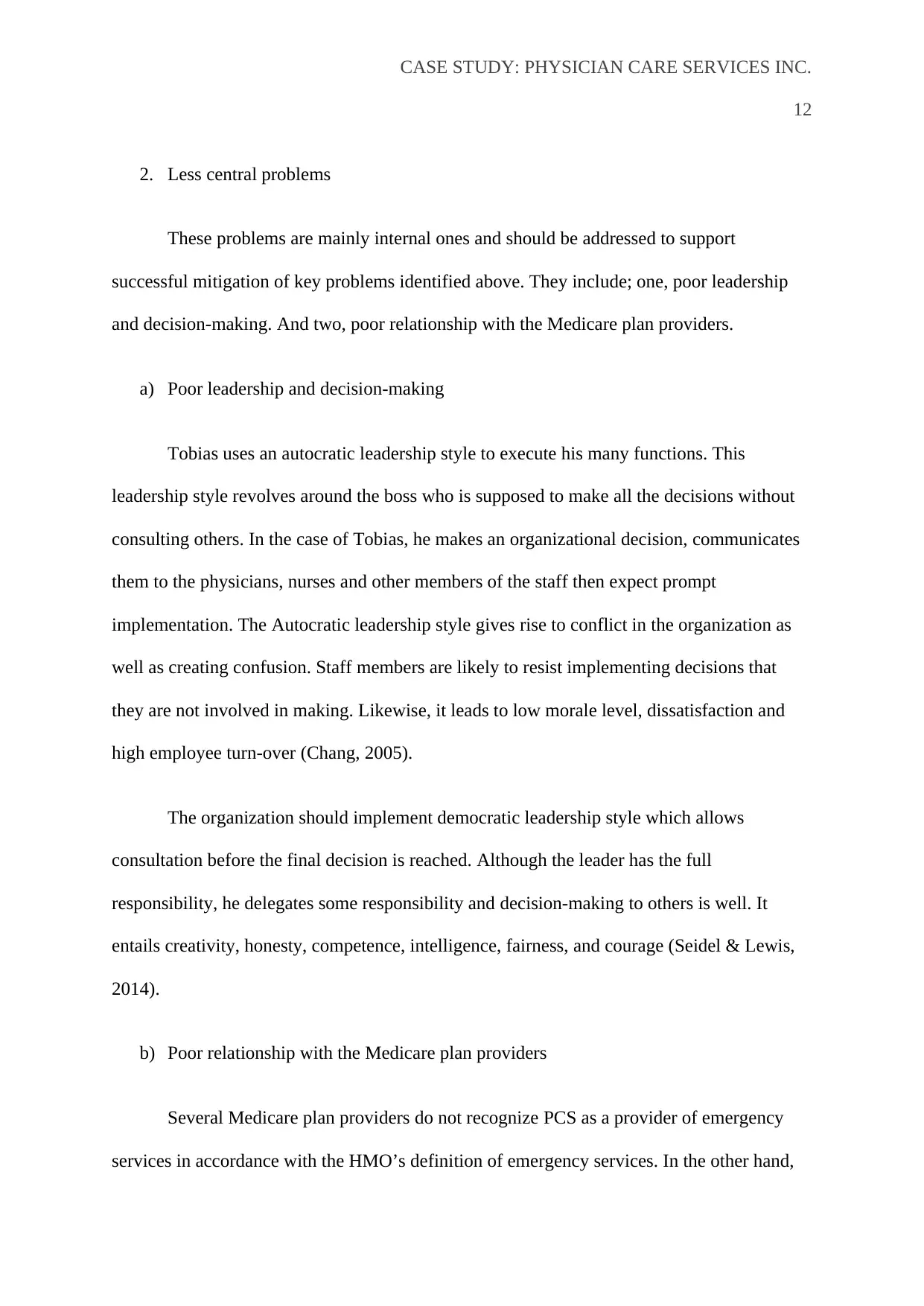
CASE STUDY: PHYSICIAN CARE SERVICES INC.
12
2. Less central problems
These problems are mainly internal ones and should be addressed to support
successful mitigation of key problems identified above. They include; one, poor leadership
and decision-making. And two, poor relationship with the Medicare plan providers.
a) Poor leadership and decision-making
Tobias uses an autocratic leadership style to execute his many functions. This
leadership style revolves around the boss who is supposed to make all the decisions without
consulting others. In the case of Tobias, he makes an organizational decision, communicates
them to the physicians, nurses and other members of the staff then expect prompt
implementation. The Autocratic leadership style gives rise to conflict in the organization as
well as creating confusion. Staff members are likely to resist implementing decisions that
they are not involved in making. Likewise, it leads to low morale level, dissatisfaction and
high employee turn-over (Chang, 2005).
The organization should implement democratic leadership style which allows
consultation before the final decision is reached. Although the leader has the full
responsibility, he delegates some responsibility and decision-making to others is well. It
entails creativity, honesty, competence, intelligence, fairness, and courage (Seidel & Lewis,
2014).
b) Poor relationship with the Medicare plan providers
Several Medicare plan providers do not recognize PCS as a provider of emergency
services in accordance with the HMO’s definition of emergency services. In the other hand,
12
2. Less central problems
These problems are mainly internal ones and should be addressed to support
successful mitigation of key problems identified above. They include; one, poor leadership
and decision-making. And two, poor relationship with the Medicare plan providers.
a) Poor leadership and decision-making
Tobias uses an autocratic leadership style to execute his many functions. This
leadership style revolves around the boss who is supposed to make all the decisions without
consulting others. In the case of Tobias, he makes an organizational decision, communicates
them to the physicians, nurses and other members of the staff then expect prompt
implementation. The Autocratic leadership style gives rise to conflict in the organization as
well as creating confusion. Staff members are likely to resist implementing decisions that
they are not involved in making. Likewise, it leads to low morale level, dissatisfaction and
high employee turn-over (Chang, 2005).
The organization should implement democratic leadership style which allows
consultation before the final decision is reached. Although the leader has the full
responsibility, he delegates some responsibility and decision-making to others is well. It
entails creativity, honesty, competence, intelligence, fairness, and courage (Seidel & Lewis,
2014).
b) Poor relationship with the Medicare plan providers
Several Medicare plan providers do not recognize PCS as a provider of emergency
services in accordance with the HMO’s definition of emergency services. In the other hand,
⊘ This is a preview!⊘
Do you want full access?
Subscribe today to unlock all pages.

Trusted by 1+ million students worldwide
1 out of 22
Your All-in-One AI-Powered Toolkit for Academic Success.
+13062052269
info@desklib.com
Available 24*7 on WhatsApp / Email
![[object Object]](/_next/static/media/star-bottom.7253800d.svg)
Unlock your academic potential
Copyright © 2020–2025 A2Z Services. All Rights Reserved. Developed and managed by ZUCOL.

